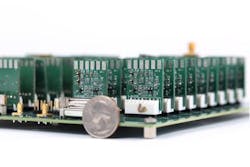Microsecond Raman spectroscopy tool has potential in medical diagnostics
Researchers at Purdue University (West Lafayette, IN) used a vibrational spectroscopy technology that can take images of living cells. The work could someday represent an advanced medical diagnostic tool for early detection of cancer and other diseases.
Related: Converting molecular vibration to mechanical for deep-tissue imaging
High-speed spectroscopic imaging makes it possible to observe the quickly changing metabolic processes inside living cells and to image large areas of tissue, making it possible to scan an entire organ.
"For example, we will be able to image the esophagus or urinary bladder for diagnosis of tumors," says Ji-Xin Cheng, a professor in Purdue University's Weldon School of Biomedical Engineering and Department of Chemistry. "If you were to take one millisecond per pixel, then it would take 10 minutes to obtain an image, and that's too slow to see what's happening in cells. Now we can take a complete scan in two seconds."
The technology represents a new way to use stimulated Raman scattering (SRS) to perform microsecond-speed vibrational spectroscopic imaging, which can identify and track certain molecules by measuring their vibrational spectrum with a laser.
The imaging technique is "label-free," meaning it does not require samples to be marked with dyes, making it appealing for diagnostic applications. Another advantage of the new system is that it can be combined with another technique called flow cytometry to look at a million cells per second.
"You can look at large numbers of cells from a patient's blood sample to detect tumors, for example, and you can also look directly at organs with an endoscope," says Cheng, scientific director of the Label-free Imaging lab in the Birck Nanotechnology Center in Purdue's Discovery Park. "These capabilities will change how people use Raman spectroscopy for medicine. There are many organelles in each cell, and spectroscopy can tell us what's in the organelles, which is information not available by other techniques."
As a proof of concept, the researchers demonstrated the new system by observing how human cancer cells metabolize vitamin A and how medications are distributed in the skin.
The technology, which is about 1000x faster than a state-of-the-art commercial Raman microscope, is made possible with an electronic device developed at the Jonathan Amy Facility called a 32-channel tuned amplifier array (TAMP array).
Two patents have been issued for the new technology. Cheng says the idea for this imaging technology was inspired by teaching undergraduates how the human ear amplifies sound. Circuits in the TAMP device do the same thing for optical signals, he says.
Full details of the work appear in the journal Light: Science & Applications; for more information, please visit http://dx.doi.org/10.1038/lsa.2015.38.
-----
Follow us on Twitter, 'like' us on Facebook, connect with us on Google+, and join our group on LinkedIn

